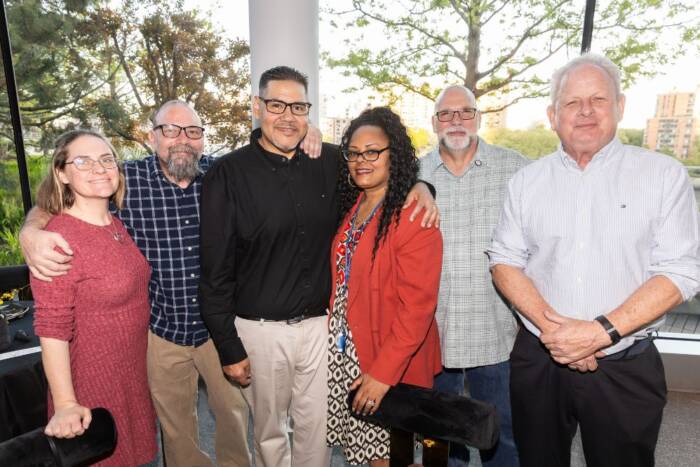Stanford veterinarian named new LARC director
by TALLEY HENNING BROWN
 (opens in new window)Ravi Tolwani, a veterinarian who spent over a dozen years in Stanford University’s animal research facility, has been hired to take over the directorship of the Laboratory Animal Research Center upon the retirement of current director Fred Quimby this summer. Dr. Tolwani joined Rockefeller University in February; he and Dr. Quimby will share responsibility for LARC during a six-month transition.
(opens in new window)Ravi Tolwani, a veterinarian who spent over a dozen years in Stanford University’s animal research facility, has been hired to take over the directorship of the Laboratory Animal Research Center upon the retirement of current director Fred Quimby this summer. Dr. Tolwani joined Rockefeller University in February; he and Dr. Quimby will share responsibility for LARC during a six-month transition.
Dr. Tolwani, who was born in India and raised in the United States, holds a doctorate of veterinary medicine from Auburn University, in Alabama. After two years in private practice, treating pets in Nashville, Tennessee, he turned to research, completing a residency and postdoc in molecular and cellular pathology and laboratory animal/comparative medicine at the University of Alabama, Birmingham. He then remained at the school to pursue a Ph.D. in molecular and cellular pathology, which he received in 1994. For his research he developed a mouse model to study a common illness in humans associated with an enzyme deficiency in fat metabolism.
Dr. Tolwani joined Stanford University in 1994, as clinical veterinarian at the Veterinary Service Center (VSC), Stanford’s equivalent of LARC. He also served on the faculty in the department of comparative medicine within the school of medicine where his laboratory focused on understanding the molecular mechanisms of brain plasticity.
In the fall of 2005, Dr. Tolwani’s career took an unusual detour: On sabbatical from his academic position, he entered the Stanford Graduate School of Business and earned a master of science in management degree, an MBA equivalent for mid-career professionals. “In academia, we’re generally focused in one area of the scientific enterprise, but being involved with business students from other fields — private equity, marketing, information technology — was a tremendous experience,” he says.
The phone call from Rockefeller came shortly after completing the program. “Ravi is one of the brightest young stars in his field, and quite unique. I don’t know of anybody with his combination of degrees, and his reputation as a researcher precedes him as well,” says Dr. Quimby, who led the search for the new senior director and actively recruited Dr. Tolwani to the position. “The search committee interviewed several candidates, but the moment they met with Ravi, it was clear he was the one they wanted.” In addition to his current position as associate vice president and senior director of LARC, Dr. Tolwani will receive an appointment as research associate professor. “My interest in mouse behavior, and my expertise in that area, will hopefully allow me to do some collaborative work while I’m here,” says Dr. Tolwani.
Demand for animal research facilities at Rockefeller has grown rapidly over the past several years as genetically altered “knockout” and “knockin” mice have become increasingly important to biologists who work to understand the connections between genes and disease.
When he takes over in September, Dr. Tolwani will oversee LARC’s approximately 90 employees, most of whom are involved in the care of research animals and assisting with research protocols. Three full-time veterinarians oversee the health of the animals and consult with investigators. They are supported by seven veterinary health technicians who direct the sentinel and quarantine programs and conduct clinical rounds and who are in turn assisted by more than 40 animal attendants in charge of cage sanitation, monitoring of the animals and various other regular husbandry procedures. Various specialists, including experts in veterinary pathology, transgenics and gene targeting, also support the facility.
And the center continues to grow rapidly. Dr. Tolwani will take over as LARC begins a major expansion, with work scheduled to start this year on both an annex to the existing building and a shared mouse-breeding facility in Yonkers.
The Annex, to be built adjacent to the existing LARC facility, will be devoted to research into animal behavior. Four floors will house lab spaces for investigators whose primary focus is neuroscience and behavioral science. Groundbreaking is scheduled for December, and the building should be complete by early 2009.
This December is also the start date for the renovation of an existing building in Yonkers to house a new mouse-breeding facility. The construction is partially funded by a $10 million grant from New York State to the Academic Medicine Development Company (AMDeC), a nonprofit consortium of New York health and medical institutions of which Rockefeller is a member. The Shared-use Mouse Facility will provide research animals for use by four member institutions: Mount Sinai Medical Center, North Shore-Long Island Jewish Health System, New York University Medical Center and Rockefeller University. AMDeC is in the process of choosing a commercial partner to run daily operations at the facility.
Under Dr. Tolwani’s guidance, these ambitious building projects will be accompanied by upgrades in technology, equipment and services. Already, the university has finalized an agreement with Transnetyx, a molecular diagnostics company, for discounted genotyping services, and it is considering plans to add imaging technologies such as bioluminescence imaging for in vivo studies.
Dr. Tolwani will emphasize strengthening the collaborative relationship between investigators and LARC staff, including launching a series of informal lectures and demonstrations, conducted by Rockefeller’s researchers, to help build new skills for LARC’s veterinary technicians and animal husbandry staff.
“I’m fortunate to be inheriting a facility that has done enormously well under Fred, and I see my role as helping further optimize the programs that he has built. I hope to enable our staff to perform more outreach with postdocs and students and deliver better service to the investigators,” Dr. Tolwani says. “My mandate here is to help the science, and what I really enjoy doing is talking to the investigators, helping them with animal model selection, experimental protocol optimizations and other issues.”
| Of mice and men Over his six-year tenure Fred Quimby built LARC into a state-of-the-art research facility that quietly drives much of Rockefeller’s scienceWhen Fred Quimby came to Rockefeller in 2001, his arrival had been eagerly anticipated. The Laboratory Animal Research Center, its recent history marked by high turnover of its leadership, was in dire need of both physical and operational reformation. Dr. Quimby, who will retire from his post as associate vice president and senior director of LARC at the end of August, was the man brought in to clean things up. Within a month of his arrival, Dr. Quimby had completed an analysis and provided a detailed report on problems to be addressed in the 30-year-old center’s operations. His first priority was to address capacity issues. The mouse rooms were full and in several cases, important experiments were stalled while faculty waited to get space for more animals. In his first year Dr. Quimby installed specialized wall-mounted racks and “mice condominiums” that increased the number of cages in each room to 504, nearly three times the rooms’ original capacity. He then automated many of the labs’ systems, including those for ventilation and sanitization of cages, temperature and humidity control and security, measures that reduced the amount of labor needed to complete routine tasks and improved quality control, helping prevent outbreaks of disease. Battling viral infection, literally the plague of animal research facilities, was also at the top of Dr. Quimby’s list. “We began an extremely intense program for detecting when an infectious agent is inadvertently introduced, based on ‘sentinel’ cages that function like the canary in the coal mine,” Dr. Quimby explains. Sentinel cages — there’s one every 36 cages — come into regular contact with used bedding from other cages, and each houses four mice that are tested once a month for 20 different infectious agents, essentially every known mouse pathogen. Strict rules were also developed governing access to the mouse rooms, quarantines for new mice and the meticulous use of logs to record the movement of cages from one laboratory to another. These measures reduced the incidence of infection at LARC to dramatically low numbers. There was another problem, common in the field of laboratory animal research: staffing. To address chronic labor shortages, Dr. Quimby instituted several programs. He began a postgraduate training program for veterinarians wishing to specialize in laboratory animal medicine, a program through LaGuardia Community College to train veterinary technicians and a high school vocational program, coordinated with the Manhattan Comprehensive Night and Day High School, to train students in laboratory animal science. In the previous three years, the latter program produced 37 well-trained students, some of whom went on to college and some of whom became nationally certified and are actively engaged in the field; 23 of those graduates currently work at LARC. This year’s program will produce 10 more students. “Under Fred’s leadership and guidance, LARC has been transformed into a world-class facility that meets the demanding needs of our world-class faculty,” says John Tooze, vice president for scientific and facility operations. “In addition to the changes that have been implemented over the last six years, Fred has laid the groundwork for expanded capacity and new services that will help drive the university’s science for years to come.” |


